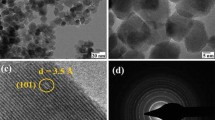Abstract
Nanocrystalline titanium dioxide particles with anatase structure and high thermal stability have been synthesized using the basic sol-gel method. The particle size and morphology were refined under hydrothermal conditions in the presence of different concentrations of tetramethylammonium hydroxide (TMAH) at 210°C and 230°C. XRD and TEM analysis showed that the TiO2 particles obtained were homogeneous and monodispersive at low contents of TMAH. All intense peaks, clearly observed in the XRD patterns, were assigned to the anatase phase and no rutile phase was observed. At high contents of TMAH, nanoscale small (10–30 nm) and larger (>100 nm) TiO2 particles were one-pot synthesized. The nanocrystalline TiO2 particles synthesized by this method have good thermal stability. With the sintering temperature of up to 650°C, all the XRD peaks maintained good agreement with the anatase reference data.
Similar content being viewed by others
References
Barbé, C. J., Arendse, F., Comte, P., Jirousek, M., Lenzmann, F., Shklover, V., & Gräzel, M. (1997). Nanocrystalline titanium oxide electrodes for photovoltaic applications. Journal of American Ceramic Society, 80, 3157–3171. DOI:10.1111/j.1151-2916.1997.tb03245.x.
Burnside, S. D., Shklover, V., Barbé, C., Comte, P., Arendse, F. Brooks, K., & Grätzel, M. (1998). Self-organization of TiO2 nanoparticles in thin films. Chemistry of Materials, 10, 2419–2425. DOI: 10.1021/cm980702b.
Chemseddine, A., & Moritz, T. (1999). Nanostructuring titania: control over nanocrystal structure, size, shape, and organization. European Journal of Inorganic Chemistry, 1999, 235–245. DOI: 10.1002/(SICI)1099-0682(19990202)1999:2〈235:: AIDEJIC235〉 3.0.CO;2-N.
Grätzel, M. (2004). Conversion of sunlight to electric power by nanocrystalline dye-sensitized solar cells. Journal of Photochemical Photobiology A: Chemistry, 164, 3–14. DOI:10.1016/j.jphotochem.2004.02.023.
Harizanov, O., & Harizanova, A. (2000). Development and investigation of sol-gel solutions for the formation of TiO2 coatings. Solar Energy Materials and Solar Cells, 63, 185–195. DOI: 10.1016/S0927-0248(00)00008-8.
Hore, S., Palomares, E., Smit, H., Bakker, N. J., Comte, P., Liska, P., Thampi, K. R., Kroon, J. M., Hinsch, A., & Durrant, J. R. (2005). Acid versus base peptization of mesoporous nanocrystalline TiO2 films: functional studies in dye sensitized solar cells. Journal of Materials Chemistry, 15, 412–418. DOI: 10.1039/b407963a.
Hu, L. H., Dai, S. Y., & Wang, K. J. (2003). Structural transformation of nanocrystalline titania grown by sol-gel technique and the growth kinetics of crystallites. Acta Physica Sinica, 52, 2135–2139 (in Chinese).
Koelsch, M., Cassaignon, S., Minh, C. T. T., Guillemoles J. F., & Jolivet, J. P. (2004). Electrochemical comparative study of titania (anatase, brookite, and rutile) nanoparticles synthesized in aqueous medium. Thin Solid Films, 451–452, 86–92. DOI: 10.1016/j.tsf.2003.11.150.
Nakade, S., Matsuda, M., Kambe, S., Saito, Y., Kitamura, T., Sakata, T., Wada, Y., Mori, H., & Yanagida, S. (2002). Dependence of TiO2 nanoparticle preparation methods and annealing temperature on the efficiency of dye-sensitized solar cells. Journal of Physical Chemistry B, 106, 10004–10010. DOI: 10.1021/jp020051d.
Nazeeruddin, M. K., Kay, A., Rodicio, I., Humphry-Baker, R., Muller, E., Liska, P., Vlachopoulos, N., & Grätzel, M. (1993). Conversion of light to electricity by cis-X2bis(2,2′-bipyridyl-4,4′-dicarboxylate) ruthenium (II) charge-transfer sensitizers (X = Cl−, Br−, I−, CN−, and SCN−) on nanocrystalline TiO2 electrodes. Journal of the American Chemical Society, 115, 6382–6390. DOI: 10.1021/ja00067a063.
O’Regan, B., & Grätzel, M. (1991). A low-cost, high-efficiency solar cell based on dye-sensitized colloidal TiO2 films. Nature, 353, 737–740. DOI: 10.1038/353737a0.
Park, N. G., Schlichthörl, G., van de Lagemaat, J., Cheong, H. M., Mascarenhas, A., & Frank, A. J. (1999). Dye-sensitized TiO2 solar cells: structural and photoelectrochemical characterization of nanocrystalline electrodes formed from the hydrolysis of TiCl4. Journal of Physical Chemistry B, 103, 3308–3314. DOI: 10.1021/jp984529i.
Park, N. G., van de Lagemaat, J., & Frank, A. J. (2000). Comparison of dye-sensitized rutile-and anatase-based TiO2 solar cells. Journal of Physical Chemistry B, 104, 8989–8994. DOI: 10.1021/jp994365l.
Uchida, S., Tomiha, M., Masaki, N., Miyazawa, A., & Takizawa, H. (2004). Preparation of TiO2 nanocrystalline electrode for dye-sensitized solar cells by 28 GHz microwave irradiation. Solar Energy Materials and Solar Cells, 81, 135–139. DOI: 10.1016 /j.solmat.2003.08.020.
Wang, R. B., Dai, S. Y., & Wang, K. J. (2002). The influence of pH to prepare TiO2 by sol-gel and the characteristics. Journal of Functional Materials, 33, 296–297.
Wang, P., Zakeeruddin, S. M., Comte, P., Charvet, R., Humphry-Baker, R., & Grätzel, M. (2003). Enhance the performance of dye-sensitized solar cells by co-grafting amphiphilic sensitizer and hexadecylmalonic acid on TiO2 nanocrystals. Journal of Physical Chemistry B, 107, 14336–14341. DOI: 10.1021/jp0365965.
Wang, Z.-S., Kawauchi, H., Kashima, T., & Arakawa, H. (2004). Significant influence of TiO2 photoelectrode morphology on the energy conversion efficiency of N719 dye-sensitized solar cell. Coordination Chemistry Reviews, 248, 1381–1389. DOI: 10.1016 /j.ccr.2004.03.006.
Wang, Z.-S., Yamaguchi, T., Sugihara, H., & Arakawa, H. (2005). Significant efficiency improvement of the black dyesensitized solar cell through protonation of TiO2 films. Langmuir, 21, 4272–4276. DOI: 10.1021/la050134w.
Yang, J., Li, D., Wu, D. H., Yang, X. J., Lu, L. D., & Wang, X. (2001). Preparation of doped nanocrystalline TiO2 and microstructural control by stearic acid sol-gel method. Journal of Inorganic Materials, 16, 550–554.
Zukalová, M., Zukal, A., Kavan, L. Nazeeruddin, M. K., Liska, P., & Grätzel, M. (2005). Organized mesoporous TiO2 films exhibiting greatly enhanced performance in dyesensitized solar cells. Nano Letters, 5, 1789–1792. DOI: 10.1021/nl051401l.
Author information
Authors and Affiliations
Corresponding author
Rights and permissions
About this article
Cite this article
Bi-Tao, X., Bao-Xue, Z., Long-Hai, L. et al. Preparation of nanocrystalline anatase TiO2 using basic sol-gel method. Chem. Pap. 62, 382–387 (2008). https://doi.org/10.2478/s11696-008-0040-0
Received:
Revised:
Accepted:
Published:
Issue Date:
DOI: https://doi.org/10.2478/s11696-008-0040-0



